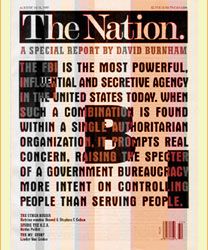When TRAC began exploring
Justice Department data concerning the performance of FBI before
putting up its public FBI web site (http://trac.syr.edu)
two years ago, it realized that the challenge was a big one. Up
to that time, no one had ever undertaken a comprehensive study
of what the FBI actually was doing. There had been the usual leaks
about the "good" cases the FBI wanted to publicize and some harsh
criticism of a handful of "bad" cases (Waco, Ruby Ridge, the crime
lab) that the bureau would have loved to suppress. But because
of the FBI's obsession with secrecy, the patterns and trends of
the investigative activities were totally unknown. With a grant
from the Nation Institute, TRAC began analyzing the data that
now concern more than 40,000 referrals for prosecution each year.
After months of analysis and reporting by TRAC's co-directors
-- David Burnham and Susan B. Long -- the findings were summarized
in a magazine-long article in the August 11/18, 1997 issue of
The Nation. One key finding: more than half of the FBI's 12,000
convictions involved drugs, bank robberies and fraud against banks,
matters that in most cases could have been dealt with by local
police. By contrast, according to the Justice Department, there
were only 148 convictions that were categorized as involving medical
fraud. At the time the Nation article was published, TRAC's FBI
web site became available for public inspection.


























